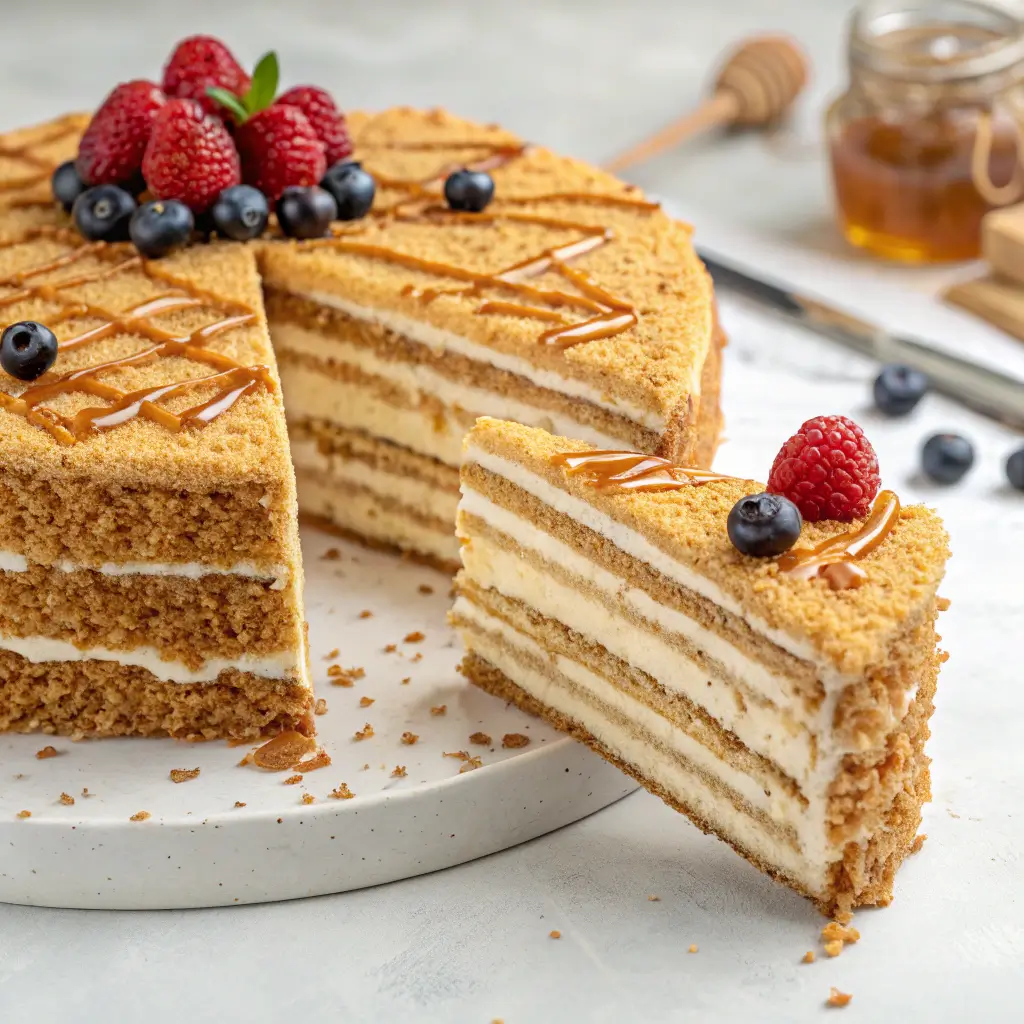Authentic Russian Honey Cake (Medovik) – Comprehensive Baking Guide
Understanding the Traditional Russian Honey Cake
Medovik represents a classic Russian layered dessert that has gained international recognition for its distinctive honey flavor and delicate texture. This cake consists of multiple thin, honey-sweetened layers alternated with a rich sour cream-based frosting. What sets Medovik apart from other layered cakes is its unique characteristic of becoming more tender over time as the cake layers absorb moisture from the frosting.
Historical Context and Cultural Importance
The creation of Medovik dates back to imperial Russia during the early 1800s. Historical records indicate that a royal chef developed this dessert specifically for Empress Elizabeth Alexeievna, who reportedly disliked honey but ultimately adored this particular preparation. The cake’s popularity spread beyond aristocratic circles and became a staple in Russian households due to several practical advantages:
- Utilization of basic pantry staples
- Extended preservation qualities from honey’s natural properties
- Adaptability for large-scale preparation
- Versatility for various celebrations and gatherings

Detailed Ingredient Analysis
Cake Layer Components
- Natural honey (½ cup): Provides the signature taste profile and maintains moisture
- White granulated sugar (¾ cup): Complements honey’s flavor while aiding browning
- High-quality butter (½ cup): Contributes to dough pliability and richness
- Fresh eggs (3 large): Ensure proper binding and structure
- Leavening agent (1 tsp baking soda): Creates necessary lift
- All-purpose flour (3 cups): Forms the structural foundation
Frosting Ingredients
- Full-fat sour cream (3 cups): Delivers characteristic tanginess
- Heavy cream (1½ cups): Provides lightness and volume
- Confectioners’ sugar (1 cup): Offers smooth sweetness
- Pure vanilla extract (1 tsp): Enhances flavor complexity
Comprehensive Preparation Method
Dough Preparation Process
- Melting phase: Combine honey, sugar, and butter in a heavy-bottomed saucepan. Heat gently at medium-low temperature with constant stirring until fully homogenized. Remove from heat source and allow partial cooling.
- Egg incorporation: Introduce eggs individually, thoroughly blending after each addition until achieving a uniform consistency.
- Dry ingredient integration: Methodically add baking soda followed by gradual flour incorporation, mixing until achieving a cohesive, slightly tacky dough mass.
Layer Formation Technique
- Portion division: Separate dough into eight equal mass portions (approximately 4 ounces each), shaping into uniform spheres.
- Rolling procedure:
- Position dough ball between parchment sheets
- Roll to achieve 8-inch diameter circles of consistent thickness
- Repeat process for all portions
- Baking protocol:
- Preheat baking appliance to 350°F (175°C)
- Bake individual layers for 5-7 minutes until achieving golden coloration
- Transfer to cooling racks for complete temperature reduction
Frosting Preparation
- Cream aeration: Whip chilled heavy cream to soft peak stage.
- Final composition: Gently incorporate sour cream, powdered sugar, and vanilla extract until reaching optimal spreading consistency.
Assembly Methodology
- Base establishment: Position initial cake layer on stable serving surface.
- Layering sequence: Apply approximately ¼ cup frosting between each subsequent layer.
- Final coating: Utilize remaining frosting for complete exterior coverage.
- Optional embellishment: Adhere reserved cake particulates to vertical surfaces for traditional appearance.
Professional Techniques for Optimal Results
- Ingredient temperature management: Maintain room temperature conditions for all components except whipping cream.
- Dough handling: Implement brief chilling for improved workability if dough exhibits excessive adhesion.
- Baking consistency: Rotate baking vessel midway through cooking duration for even coloration.
- Frosting stabilization: Refrigerate frosting mixture if consistency appears insufficiently viscous.
- Maturation period: Allow minimum 6-hour refrigeration (preferably overnight) for ideal texture development.
Troubleshooting Common Issues
Concern: Excessive layer crispness post-baking
Resolution: Proper frosting application and adequate chilling will facilitate softening
Concern: Frosting fluidity issues
Resolution: Achieve firmer cream peaks and pre-chill mixture
Concern: Dough handling difficulties
Resolution: Adjust flour content or implement brief resting period
Presentation and Service Recommendations
Traditional serving approaches include:
- Accompaniment with robust black tea preparations
- Pairing with concentrated coffee beverages
- Complementing with fresh berry selections
Enhanced presentation options:
- Application of edible metallic leaf decorations
- Incorporation of crystallized citrus peel
- Artistic chocolate patterning
- Food-grade floral arrangements
Preservation and Storage Guidelines
Refrigerated storage:
- Maintain under protective covering for up to five days
- Allow brief ambient temperature adjustment before service
Freezing protocol:
- Implement tight plastic wrap enclosure followed by foil barrier
- Preserve frozen state for maximum one month duration
- Execute gradual refrigerator thawing before consumption

Nutritional Composition Overview
Approximate values per standard serving (1/12 portion):
- Energy content: 420-450 kcal
- Carbohydrate content: 55-60g
- Protein content: 6-7g
- Lipid content: 20-22g
Contemporary Interpretations and Variations
Modern adaptations include:
- Chocolate-infused version: Cocoa powder integration into dough
- Nut-incorporated variation: Finely ground nut integration into frosting
- Fruit-enhanced preparation: Layered fruit preserves or curds
- Coffee-flavored adaptation: Espresso powder addition to dough mixture
Final Observations on Mastering Medovik
The creation of an authentic Russian honey cake demands meticulous attention to detail throughout the preparation process. This comprehensive guide provides all necessary information to produce a Medovik that exemplifies traditional quality standards. The cake’s unique characteristic of improving in texture and flavor integration over time makes it particularly suitable for advance preparation.
Whether crafted for cultural celebration or culinary exploration, this Medovik recipe offers a genuine representation of Russian patisserie tradition. The harmonious balance of honeyed cake layers with luscious frosting creates a dessert experience that satisfies both refined and casual palates alike.

